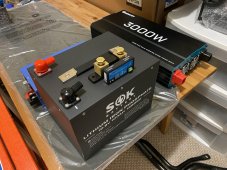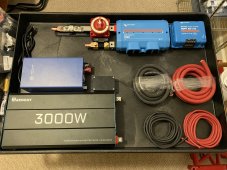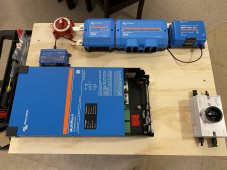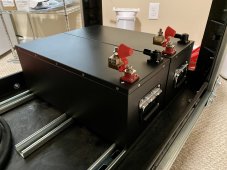I am piecing together a "solar generator" with which I intend on running two deep freezers (one with a defrost cycle), one full size fridge/freezer, and one small dorm-sized fridge. We live in the suburbs and are on the grid, so this will be for power outages only. I have a Kill-a-Watt and was going to plug in each one for a few days to get some KWh numbers to see what I needed as far as sizing... Well that didn't happen and I decided to haul off and start buying stuff instead.
Below is what I have so far:


The Victron Power In will be modified to use Mega fuses. I need to decide on panels and some sort of disconnect for them. I also will be buying two of the SOK 206AH batteries to run in parallel instead of the single 100AH that I initially bought.
I want all of it to be portable, so I am putting it on a Rubbermaid cart. I still need to buy a piece of plywood to mount everything to, but it will be laid out basically like you see it, unless someone has any better ideas. Batteries will be on the bottom of the cart, obviously.
Let me know what you think. Ideas on panels? I am thinking about a way to attach a mount to the side of the cart to hang them on for storage. Maybe hang an extension cord reel on the end for the solar cabling... Not really sure, but love to hear some feedback!
Seth
Below is what I have so far:


The Victron Power In will be modified to use Mega fuses. I need to decide on panels and some sort of disconnect for them. I also will be buying two of the SOK 206AH batteries to run in parallel instead of the single 100AH that I initially bought.
I want all of it to be portable, so I am putting it on a Rubbermaid cart. I still need to buy a piece of plywood to mount everything to, but it will be laid out basically like you see it, unless someone has any better ideas. Batteries will be on the bottom of the cart, obviously.
Let me know what you think. Ideas on panels? I am thinking about a way to attach a mount to the side of the cart to hang them on for storage. Maybe hang an extension cord reel on the end for the solar cabling... Not really sure, but love to hear some feedback!
Seth
Last edited:







